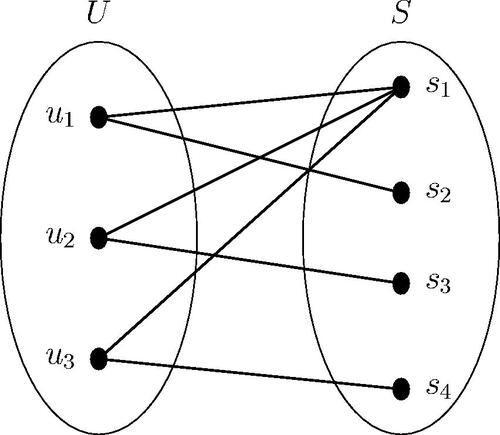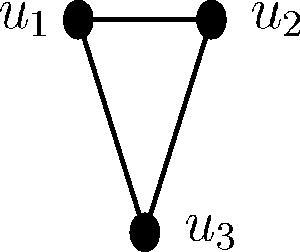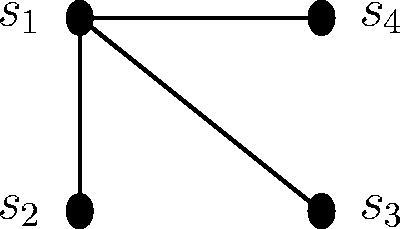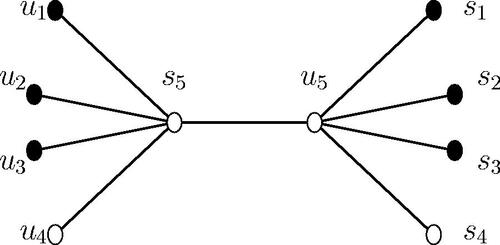 ?Mathematical formulae have been encoded as MathML and are displayed in this HTML version using MathJax in order to improve their display. Uncheck the box to turn MathJax off. This feature requires Javascript. Click on a formula to zoom.
?Mathematical formulae have been encoded as MathML and are displayed in this HTML version using MathJax in order to improve their display. Uncheck the box to turn MathJax off. This feature requires Javascript. Click on a formula to zoom.Abstract
For an ordered subset of vertices and a vertex v in a connected graph G, the ordered k-vector
is called the representation of v with respect to W, where
is the distance between v and wi, for
. The set W is called a resolving set of G if
, for every pair
. The minimum positive integer k for which G has a resolving set of cardinality k is the metric dimension of G, denoted as dim(G). A resolving set of G of cardinality dim(G) is a metric basis of G. For a bipartite graph G, projection is defined as a graph with the vertices of one of the partite sets, where two vertices are adjacent if they have at least one common neighbor in the other partite set. In this paper, we investigate the relation between the metric dimension of a bipartite graph and its projections. Furthermore, we present some realization results for the bounds on the metric dimension of a bipartite graph.
2010 AMS SUBJECT CLASSIFICATION:
1 Introduction
The study of locating the vertices in a connected graph based on a distance parameter is a crucial idea for keeping track of graph-structured networks. To monitor a network efficiently, the goal is to distinguish every pair of vertices with respect to a set with minimum number of vertices. The concept of metric dimension fulfills the requirements of our goal to oversee a network.
In this paper, we consider simple, finite, and connected graphs. The distance d(u, v) between two vertices u and v in a connected graph G is the length of a shortest u – v path in G. For an ordered subset of vertices and a vertex v in a connected graph G, the ordered k-vector
is called the representation of v with respect to W. The set W is called a resolving set of G if distinct vertices have distinct representations. A minimum resolving set is a metric basis of G and its cardinality is the metric dimension of G, denoted as dim(G). P. J. Slater [Citation12] pioneered this concept in the name of locating set. Independently, Harary and Melter [Citation9] introduced the same concept, but coined as resolving set. Garey and Johnson [Citation8] shown that finding the metric dimension of general graphs is an NP-complete problem. For a non-trivial connected graph G of order n,
. Chartrand et al. [Citation5] characterized all graphs with metric dimensions of
, or n – 2. Caceres et al. [Citation4] investigated the metric dimension of Cartesian product of graphs. For the past few decades, this study has enormous growth. For some more previous investigations on this topic, refer [Citation1, Citation3, Citation6, Citation10, Citation11].
In general, it is difficult to determine the metric dimension of an arbitrary graph. Finding exact values or reliable bounds for the metric dimension of particular classes of graphs has been the focus of a lot of research. Bipartite graph is one among the interesting graphs which can be modeled for two different sets of entities and their connections.
A bipartite graph G(V, E) is a graph whose vertex set V can be partitioned into two subsets V1 and V2 such that and each edge of G joins a vertex of V1 to a vertex of V2.
Baca et al. [Citation1] determined the metric dimension of k-regular bipartite graphs G(n, n), where or
and n is the number of vertices in each partite set. Since the problem of finding the metric dimension of a graph is NP-complete even when restricted to bipartite graphs [Citation7], this paper studies the metric dimension of bipartite graphs.
Let G(V, E) be a bipartite graph with the partite sets V1 and V2. For the purpose of convenience, we assume that and
. This results that
and
.
Definition 1.1
([Citation2]). Let be a bipartite graph with
and
. We define a graph
as the projection of the bipartite graph G for the vertex set U with respect to the vertex set S, where
and
if
, for
.
For a bipartite graph G, projection made it simple to evaluate the metric dimension of G, by taking into account fewer vertices than the original graph. In particular, a bipartite graph is compressed into a new graph called projection with fewer vertices.
A bipartite graph will always provide two projections. One for the vertex set U with respect to the vertex set S, denoted as
and the other one for the vertex set S with respect to the vertex set U, denoted as
.
Consider the bipartite graph with the partite sets
and
shown in .
The projection of the bipartite graph G for the vertex set U with respect to the vertex set S and the projection
of the bipartite graph G for the vertex set S with respect to the vertex set U are the graphs in and , respectively.
2 The metric dimension of a bipartite graph and its projections
In this section, we establish some bounds on the metric dimension of bipartite graphs through projection.
The following lemma states that the relation between the distances of two vertices in a bipartite graph and its projection.
Lemma 2.1.
Let be a connected bipartite graph. If
is the projection of G for the vertex set U with respect to the vertex set S, then
, for
.
Proof.
We can rewrite the statement of this lemma as “If is the projection of G for the vertex set U with respect to the vertex set S, then
if and only if
, for
and
.”
(If) Let be the projection of a bipartite graph
for the vertex U with respect to the vertex set S.
We proceed by induction on the distance .
Let . Since
is the projection of the bipartite graph G, there exists a vertex
such that
. Thus,
. This proves the base case. Assume that
, for
provided
. Let
. Choose a vertex
such that
. Our assumption results that
. Let P be a shortest path from ui to
of length
in G. Since
, there exists a vertex
such that
. P being a shortest path from ui to
in G, we have
. Thus, P along with the edges
and
forms a shortest path from ui to uj of length 2x in G.
(Only if) Let ui and uj be two vertices in G such that .
Claim : .
Suppose that . Without loss of generality, let
. Let
be a shortest
path of length
in
. Then the bipartite graph G yields at least
distinct vertices of S say
such that for every pair
of Q, there exists a vertex sl with
, for
. This results a
path of length
in G, which is a contradiction. In a similar manner, we reach a contradiction for
. Therefore, the result follows. □
Theorem 2.2.
Let be a connected bipartite graph. Then
, where G1 and G2 are the projections of G for the vertex set U with respect to the vertex set S and for the vertex set S with respect to the vertex set U respectively.
Proof.
Let G1 and G2 be the projections of a bipartite graph for the vertex set U with respect to the vertex set S and for the vertex set S with respect to the vertex set U, respectively. Let
and
be minimum resolving sets of G1 and G2 respectively. Set
. Since G is bipartite, we have
, for
and for all
. Hence, it remains to prove that
, for
. The projection G1 ensures that for a pair of vertices
, there is a vertex
such that
. This consequences that
. By Lemma 2.1,
. Since
, ur resolves us and ut in G. Therefore, W resolves U in G. Similarly, it can be proved that the vertices of
resolves S in G. This completes the proof. □
Theorem 2.3.
Let be a connected bipartite graph. Then
}, where G1 and G2 are the projections of G for the vertex set U with respect to the vertex set S and for the vertex set S with respect to the vertex set U respectively.
Proof.
Let G1 and G2 be the projections of a bipartite graph for the vertex set U with respect to the vertex set S and for the vertex set S with respect to the vertex set U respectively. Without loss of generality, assume that
. Let W1 be a minimum resolving set of G1 of cardinality k. Since G is a bipartite graph, by Lemma 2.1, we have
, for
. This results that W1 resolves the vertices of U in G. We consider the following three cases.
Case 1: Assume, to the contrary that , where
forms a minimum resolving set of G. Then W resolves V(G). In particular,
, for all
. This follows that
, for
and for some
. Lemma 2.1 ensures that
, for some
. However, W forms a resolving set of G1, which is a contradiction.
Case 2: Suppose is a minimum resolving set of G such that
. Let
. Then
, for all
. This consequences that
, for some
. In fact, for every
, there exists a vertex
such that
to obtain
, for all
. By Lemma 2.1, we have
. This generates a minimum resolving set
of G1 of cardinality less than k, which is a contradiction.
Case 3 : Suppose W is a minimum resolving set of G which intersects both U and S such that . Let
, where
. Let
be the vertices of U resolved by the vertices of
in G. This consequences that
, for some
. As discussed in case 2, for every
, we can associate a vertex
such that
with
, for
. By Lemma 2.1, we have
. This produces a resolving set
of G1 of cardinality less than k, which is a contradiction.
In each case, there is no resolving set W of G such that . Hence, we conclude that
. □
Next, we provide some realizable results corresponds to the Theorem 2.3.
A bipartite graph with
and
is called a chain graph if there exists an ordering
of U and an ordering
of S such that
and
.
Proposition 2.4.
Let be a connected bipartite chain graph with an ordering
of U and an ordering
of S such that
and
. Let
be the projection for one of the partite sets with respect to the other. Then
, whenever there exist
such that
, (ii)
, otherwise.
Proof.
Without loss of generality, let be the projection of G for the vertex set U with respect to the vertex set S. Since G is connected, we have
. As a result,
is a complete graph on n1 vertices and
. Let
be a minimum resolving set of
. Suppose there exist two vertices
with
. Then
. Hence,
will not be a resolving set of G. Thus, to resolve G, it is necessary to add u or v into
. This follows that
. On the hand, if there is an ordering
of S such that
, then there exist two vertices
with
, for
. Let
. Since
, we have
. However,
which resolves si and sj. Hence,
is a minimum resolving set of G. Therefore, the result follows. □
In a connected graph G, two vertices u and v are said to be distance similar if for all
. The set S of all vertices
such that
for all
is called a distance similar equivalence class in G.
Observation 2.5. If S is a distance similar equivalence class in a connected graph G with , then every resolving set of G contains at least
vertices of S.
The bipartite graph G in , has the partite sets and
. Since there are two distance similar equivalence classes
and
in G, every resolving set of G should contain the vertices of both the sets U and S.
As a result, it is interesting to learn about the bipartite graphs that are resolved by a subset of one of the partite sets. The following result guarantees the existence of a bipartite graph with a resolving set as a subset of one of the partite sets.
Let G be a graph. For a vertex , we define
. That is, Pv is the set of all pendent vertices adjacent to v. Moreover, if
, then Pv forms a distance similar equivalence class of G.
Theorem 2.6.
Let be a bipartite graph. If
, for each
, then there is a resolving set W of G such that
.
Proof.
Suppose , for every resolving set W of G. Let
be a resolving set of G such that
, where
. Since
, for all
, each
, for
forms a distance similar equivalence class of G. By Observation 2.5,
contains at least
vertices of
those distinguishes the representation of ui from others. Moreover, none of the vertices ui will resolve the vertices of
. This consequences that
is a resolving set of G, which is a contradiction. This completes the proof of the desired result. □
For a connected graph G of order n and diameter d, [Citation5]. In the following theorem, we provide the existence of a bipartite graph with
.
Theorem 2.7.
There exists a bipartite graph G of order n and diameter d such that , for each pair
, for
.
Proof.
Let d and n be positive integers with . For d = 1, the complete graph K2 is the only graph with the desired property. Suppose that
. Let G be the graph obtained from a star graph
of order
and a path
of order
by joining the vertex of degree n – d say u in H to
. Then G is a bipartite graph of order n and diameter d. Since the n – d pendent vertices of
forms a distance similar equivalence class of order n – d, by Observation 2.5, every resolving set of G contains at least
pendent vertices of
. Therefore,
. Let
, where
and
. Then
. This consequences that
. However, adding the vertex v or
to W will results a minimum resolving set for G. Therefore,
. □
3 Conclusion and scope
The problem of finding the metric dimension of a bipartite graph is NP-complete [Citation7]. This paper initiates the approach of determining the metric dimension of a bipartite graph using projection. A fascinating area for future research is similar investigation for other graph classes using projection.
Acknowledgments
The authors sincerely thank all of the anonymous reviewers for their valuable comments in improving the presentation of the paper.
Disclosure statement
The authors declare that there are no conflicts of interest.
References
- Baca, M., Baskoro, E. T., Salman, A. N. M., Saputro, S. W., Suprijanto, D. (2011). The metric dimension of regular bipartite graphs. Bull. math. Soc. Sci. Math. de Roumanie Tome 54(102): 15–28.
- Banerjee, S., Jenamani, M., Pratihar, D. K. (2017). Properties of a projected network of a bipartite network. In: 2017 International Conference on Communication and Signal Processing (ICCSP), Chennai, India, pp. 0143–0147.
- Caceres, J., Hernando, C., Mora, M., Pelayo, I. M., Puertas, M. L., Seara, C. (2005). On the metric dimension of some families of graphs. Electron. Notes Discrete Math. 22: 129–133.
- Caceres, J., Hernando, C., Mora, M., Pelayo, I. M., Puertas, M. L., Seara, C., Wood, D. R. (2007). On the metric dimension of cartesian product of graphs. SIAM J. Discrete Math. 21(2): 423–441.
- Chartrand, G., Eroh, L., Johnson, M. A., Oellermann, O. R. (2000). Resolvability in graphs and the metric dimension of a graph. Discrete Appl. Math. 105: 99–113.
- Dankelmann, P., Morgan, M. J., Rivett-Carnac, E. J. (2023). Metric dimension and diameter in bipartite graphs. Discuss. Math. Graph Theory 43(2): 487–498.
- Epstein, L., Levin, A., Woeginger, G. J. (2015). The (Weighted) metric dimension of graphs: hard and easy cases. Algorithmica 72: 1130–1171.
- Garey, M. R., Johnson, D. S. (1979). Computers and Intractability: A Guide to the Theory of NP-Completeness. New York: W. H. Freeman & Co., pp. 1–340.
- Harary, F., Melter, R. A. (1976). The metric dimension of a graph. Ars Combin. 2:191–195.
- Iswadi, H., Baskoro, E. T., Simanjuntak, R., Salman, A. N. M. (2008). The metric dimension of graph with pendant edges. J. Combin. Math. Combin. Comput. 65: 139–145.
- Khuller, S., Raghavachari, B., Rosenfeld, A. (1996). Landmarks in graphs. Discrete Appl. Math. 70: 217–229.
- Slater, P. J. (1975). Leaves of trees. Proceedings of the sixth Southeastern Conference on Combinatorics, Graph Theory and Computing. Congressus Numerantium, 14, pp. 549–559.




